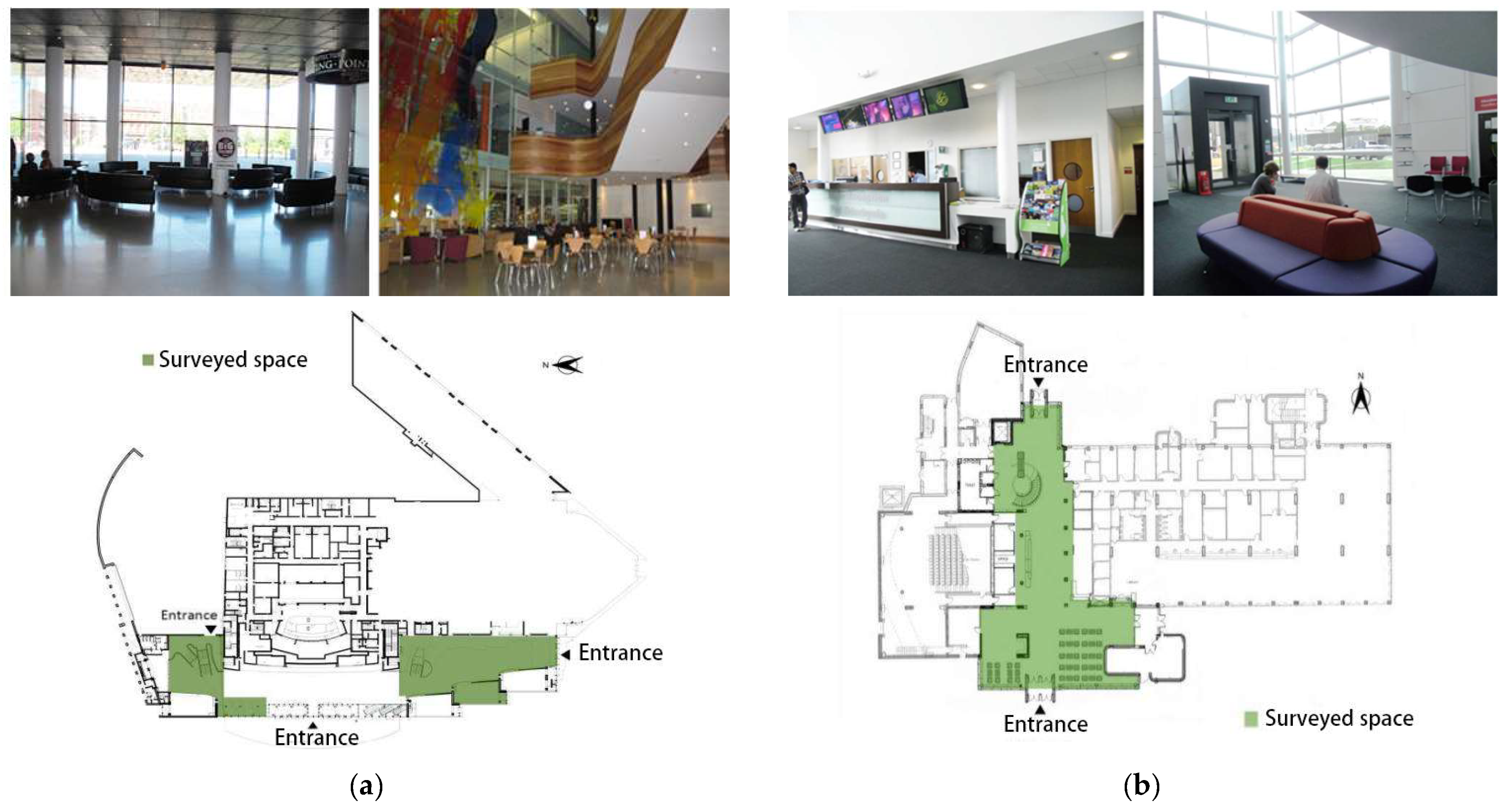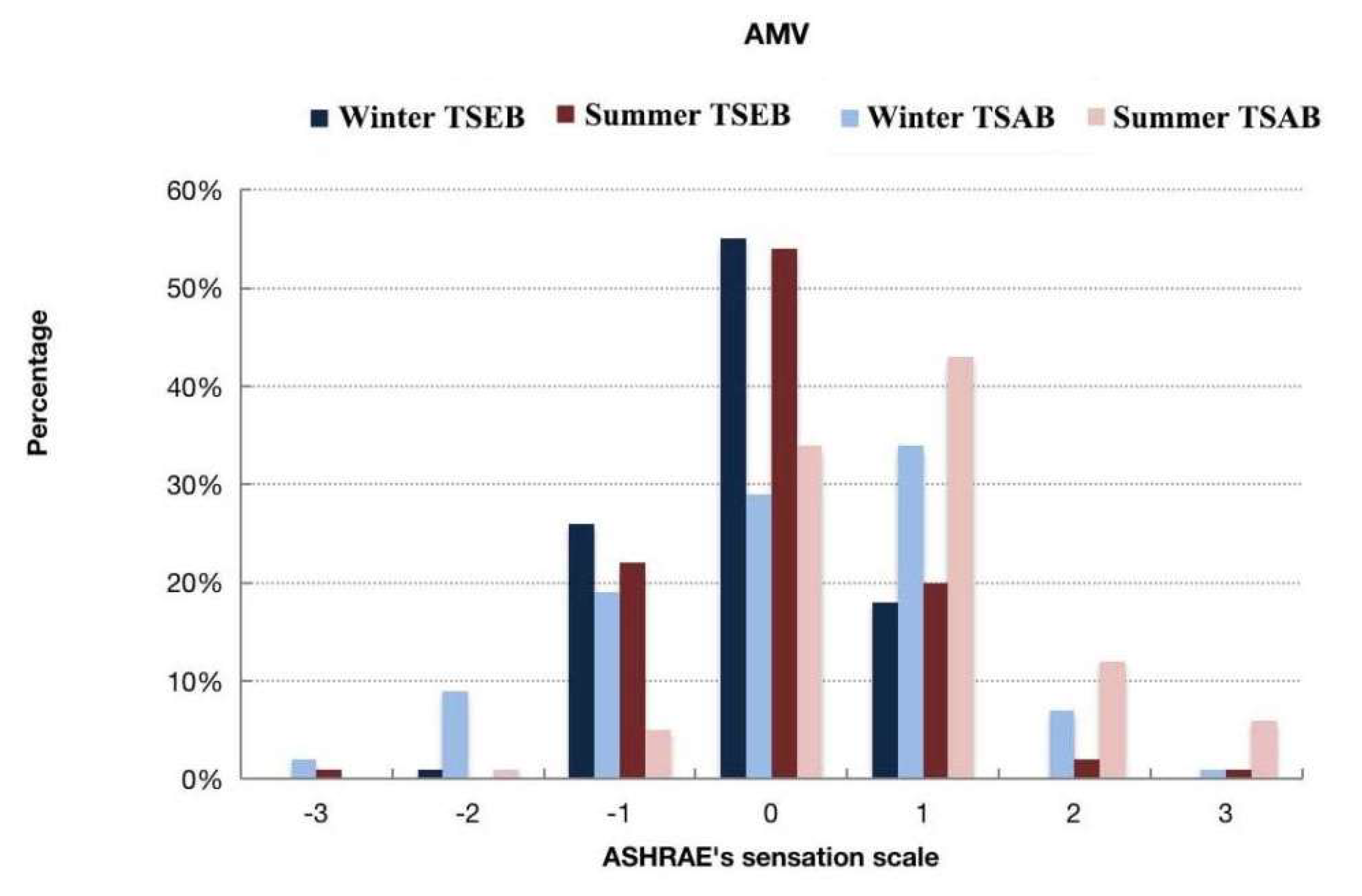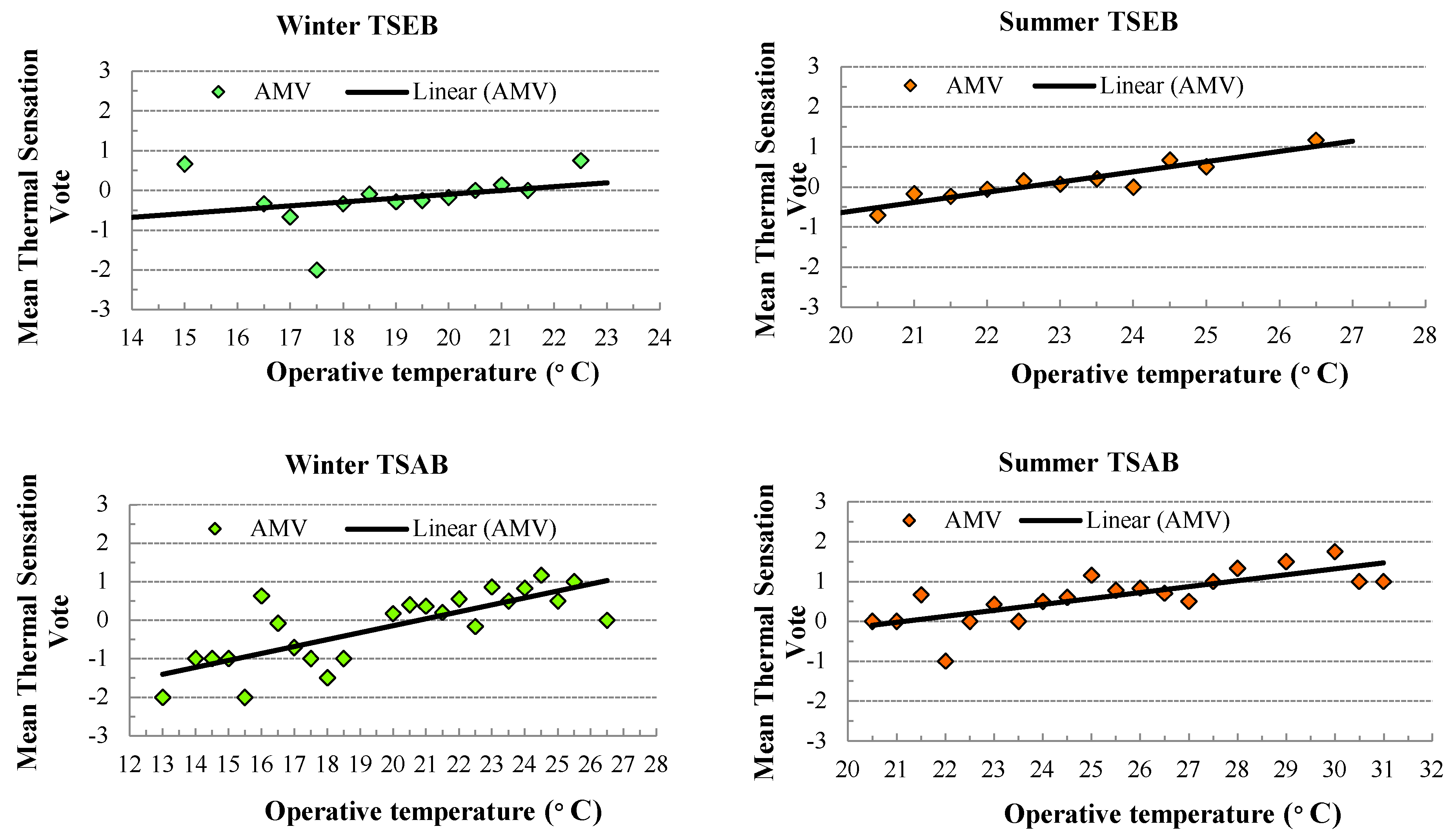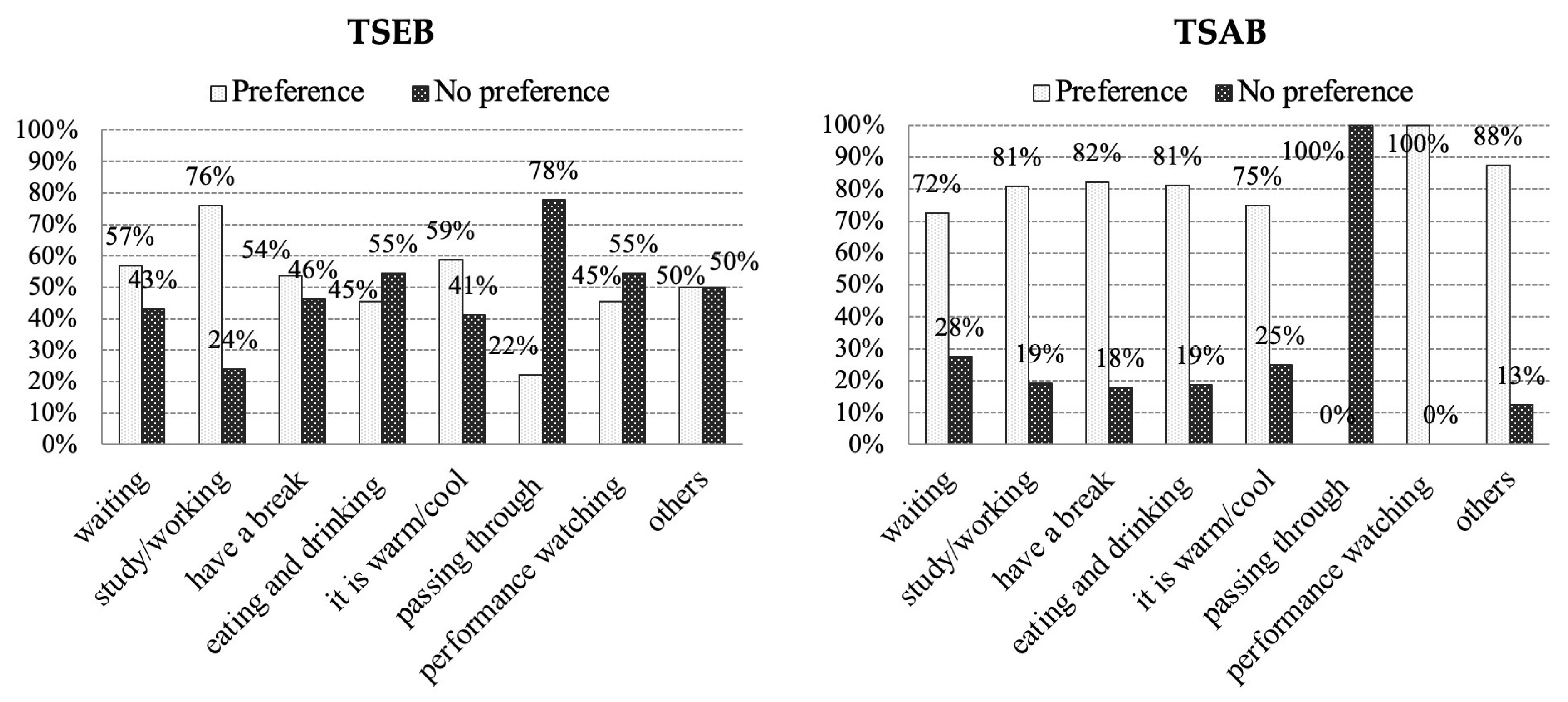An Investigation of Occupants’ Thermal Requirements in Indoor Transitional Space in Entertainment Buildings
Abstract
1. Introduction
2. Methodology
2.1. Case Study Buildings
2.2. Physical Measurements
2.3. Questionnaire Surveys
2.4. Data Analysis
3. Results and Discussion
3.1. Results from the Academic Building (with Comparisons to Existing Studies)
3.2. Results from the Entertainment Building (with Comparisons to the Academic Building)
3.2.1. Descriptive Analysis
3.2.2. Comparisons of Occupant Thermal Comfort
3.2.3. Investigation of the Thermal Conflict
3.3. Thermal Preference and the Use of the Spaces
4. Conclusions
Author Contributions
Funding
Data Availability Statement
Acknowledgments
Conflicts of Interest
Abbreviations
| ASHRAE | American Society of Heating, Refrigerating and Air-Conditioning Engineers |
| HVAC | Heating, Ventilation and Air-conditioning |
| AMV | Actual Mean Vote |
| ISO | International Organization for Standardization |
| PMV | Predicted Mean Vote |
| PPD | Predicted Percentage of Dissatisfied |
| CIBSE | Chartered Institution of Building Services Engineers |
| UK | United Kingdom |
| TSAB | Transitional Space in the Academic Building |
| TSEB | Transitional Space in the Entertainment Building |
References
- Pitts, A.; Saleh, J.B. Transition spaces and thermal comfort—Opportunities for optimising energy use. In Proceedings of the PLEA 2006—23rd International Conference on Passive and Low Energy Architecture, Geneva, Switzerland, 6–8 September 2006. [Google Scholar]
- Adrian, P. Thermal Comfort in Transition Spaces. Buildings 2013, 3, 122–142. [Google Scholar] [CrossRef]
- Ilham, S. Thermal Comfort in Transitional Spaces in Desert Communities: The Study of Cases in Tucson; The University of Arizona: Tucson, AZ, USA, 2006. [Google Scholar]
- Chun, C.; Kwok, A.; Tamura, A. Thermal comfort in transitional spaces—Basic concepts: Literature review and trial measurement. Build. Environ. 2004, 39, 1187–1192. [Google Scholar] [CrossRef]
- Pitts, A.; Saleh, J.B.; Sharples, S. Building Transition Spaces, Comfort and Energy Use. In Proceedings of the PLEA 2008—25th Conference on Passive and Low Energy Architecture, Dublin, Ireland, 22–24 October 2008. [Google Scholar]
- Pitts, A.; Saleh, J.B. Potential for energy saving in building transition spaces. Energy Build. 2007, 39, 815–822. [Google Scholar] [CrossRef]
- Pitts, A.; Douvlou-Beggiora, E. Post-occupancy analysis of comfort in glazed atrium spaces. In Proceedings of the Closing the Loop: Ways forward for Post-Occupancy Evaluation, Cumberland Lodge, Windsor, UK, 29 April–2 May 2004. [Google Scholar]
- Jitkhajornwanich, K.; Pitts, A.C.; Malama, A.; Sharples, S. Thermal comfort in transitional spaces in the cool season of Bangkok. ASHRAE Trans. 1998, 104, 1181–1193. [Google Scholar]
- Jitkhajornwanich, K.; Pitts, A. Interpretation of thermal responses of four subject groups in transitional spaces of buildings in Bangkok. Build. Environ. 2002, 37, 1193–1204. [Google Scholar] [CrossRef]
- Wu, Y.-C.; Mahdavi, A. Assessment of thermal comfort under transitional conditions. Build. Environ. 2014, 76, 30–36. [Google Scholar] [CrossRef]
- Kwong, Q.J.; Tang, S.H.; Adam, N.M. Thermal comfort evaluation of the enclosed transitional spaces in tropical building: Subjective response and computational fluid dynamics simulation. J. Appl. Sci. 2009, 9, 3480–3490. [Google Scholar] [CrossRef]
- Jie Kwong, Q.; Adam, N.M. Perception of thermal comfort in the enclosed transitional spaces in tropical building. Indoor Built Environ. 2011, 2011, 524–533. [Google Scholar] [CrossRef]
- Hui, S.C.M.; Jiang, J. Assessment of thermal comfort in transitional spaces. In Proceedings of the Joint Symposium 2014: Change in Building Services for Future, Hong Kong, China, 25 November 2014. [Google Scholar]
- Hwang, R.L.; Yang, K.H.; Chen, C.P.; Wang, S.T. Subjective responses and comfort reception in transitional spaces for guests versus staff. Build. Environ. 2008, 43, 2013–2021. [Google Scholar] [CrossRef]
- Kotopouleas, A.; Nikolopoulou, M. Understanding thermal comfort conditions in airport terminal buildings. In Proceedings of the 8th Windsor Conference: Counting the Cost of Comfort in a Changing World Cumberland Lodge, Windsor, UK, 10–13 April 2014; Network for Comfort and Energy Use in Buildings: London, UK, 2014. Available online: http://nceub.org.uk (accessed on 25 October 2014).
- Avantaggiato, M.; Belleri, A.; Oberegger, U.F.; Pasut, W. Unlocking thermal comfort in transitional spaces: A field study in three Italian shopping centres. Build. Environ. 2021, 188, 107428. [Google Scholar] [CrossRef]
- Monterio, L.M.; Alucci, M.P. Transitional spaces in São Paulo, Brazil: Mathematical modeling and empirical calubration for thermal comfort assessment. In Proceedings of the Building Performance Simulation Association Conference Exhibition, Beijing, China, 3–6 September 2007. [Google Scholar]
- Rupp, R.F.; Vásquez, N.G.; Lamberts, R. A Review of Human Thermal Comfort in the Built Environment. Energy Build. 2015, 105, 178–205. [Google Scholar] [CrossRef]
- Kotopouleas, A.; Nikolopoulou, M. Thermal comfort conditions in airport terminals: Indoor or transition spaces? Build. Environ. 2016, 99, 184–199. [Google Scholar] [CrossRef]
- Hou, G. An Investigation of Thermal Comfort and the Use of Indoor Transitional Spaces. Ph.D. Thesis, Cardiff University, Cardiff, Wales, 2016. [Google Scholar]
- Li, Y.; Geng, S.; Chen, F.; Li, C.; Zhang, X.; Dong, X. Evaluation of thermal sensation among customers: Results from field investigations in underground malls during summer in Nanjing, China. Build. Environ. 2018, 136, 28–37. [Google Scholar] [CrossRef]
- Du, X.; Zhang, Y.; Lv, Z. Investigations and analysis of indoor environment quality of green and conventional shopping mall buildings based on customers’ perception. Build. Environ. 2020, 177, 106851. [Google Scholar] [CrossRef]
- Lu, P.; Li, J. Acceptable Temperature Steps for Occupants Moving between Air Conditioned Main Space and Naturally Ventilated Transitional Space of Building. Build. Environ. 2020, 182, 107150. [Google Scholar] [CrossRef]
- ISO 7726; Ergonomics of the Thermal Environment. ISO: Geneva, Switzerland, 1998.
- ASHRAE Standard 55-2010; Thermal Environmental Conditions for Human Occupancy. ASHRAE: Atlanta, GA, USA, 2010; ISSN 1041-2336.
- Pallant, J. SPSS Survival Manual: A Step by Step Guide to Data Analysis Using the SPSS Program, 4th ed.; McGraw Hill: New York, NY, USA, 2010. [Google Scholar]
- Fanger, P.O. Thermal Comfort: Analysis and Applications in Environmental Engineering; Danish Technical Press: Copenhagen, Denmark, 1970. [Google Scholar]
- Health and Safety Statistics. 2007. Available online: https://www.hse.gov.uk/statistics/ (accessed on 21 June 2007).
- ANSI/ASHRAE Standard 55-2013; Thermal Environmental Conditions for Human Occupancy, Atlaa. ASHRAE: Atlanta, GA, USA, 2013.
- ANSI/ASHRAE Standard 55-2004; Thermal Environmental Conditions for Human Occupancy. American Society of Heating: Atlanta, GA, USA, 2004.
- Humphreys, M. Field Studies of Thermal Comfort Compared and Applied. Build. Serv. Eng. 1976, 44, 5–27. [Google Scholar] [CrossRef]
- Brager, G.S.; de Dear, R.J. Thermal adaptation in the built environment: A literature review. Energy Build. 1998, 27, 83–96. [Google Scholar] [CrossRef]
- Lin, Z.; Deng, S. A study on the thermal comfort in sleeping environments in subtropics—Developing a thermal comfort model for sleeping environments. Build. Environ. 2008, 43, 70–80. [Google Scholar] [CrossRef]
- Palme, M.; Gaona, G.; Lobato-Cordero, A.; Beltrán, R.; Gallardo, A. Evaluating thermal comfort in a naturally conditioned office in a temperate climate zone. Buildings 2016, 6, 27. [Google Scholar] [CrossRef]
- Luo, M.; Ke, Z.; Ji, W.; Wang, Z.; Cao, B.; Zhou, X.; Zhu, Y. The time-scale of thermal comfort adaptation in heated and unheated buildings. Build. Environ. 2019, 151, 175–186. [Google Scholar] [CrossRef]
- Khalid, W.; Zaki, S.A.; Rijal, H.B.; Yakub, F. Investigation of comfort temperature and thermal adaptation for patients and visitors in Malaysian hospitals. Energy Build. 2019, 183, 484–499. [Google Scholar] [CrossRef]
- Wu, Z.; Li, N.; Wargocki, P.; Peng, J.; Li, J.; Cui, H. Adaptive Thermal Comfort in Naturally Ventilated Dormitory Buildings in Changsha. Energy Build. 2019, 186, 56–70. [Google Scholar] [CrossRef]
- Nicol, F.; Humphreys, M.; Roaf, S. Adaptive Thermal Comfort: Principles and Practice; Taylor & Francis Group: London, UK, 2012. [Google Scholar] [CrossRef]
- Zaki, A.; Damiati, S.A.; Rijal, H.B.; Hagishima, A.; Razak, A.A. Adaptive thermal comfort in university classrooms in Malaysia and Japan. Build. Environ. 2017, 122, 294–306. [Google Scholar] [CrossRef]
- De Dear, R.J.; Brager, G.S. Thermal comfort in naturally ventilated buildings: Revisions to ASHRAE Standard 55. Energy Build. 2002, 34, 549–561. [Google Scholar] [CrossRef]
- Ballantyne, E.R.; Hill, R.K.; Spencer, J.W. Probit analysis of thermal sensation assessments. Int. J. Biometeorol. 1977, 21, 29–43. [Google Scholar] [CrossRef] [PubMed]
- ISO 7730; Moderate Thermal Environments—Determination of the PMV and PPD Indices and Specification of the Conditions for Thermal Comfort. International Organization for Standardization: Geneva, Switzerland, 2005.
- Bodach, S.; Lang, W.; Hamhaber, J. Climate Responsive Building Design Strategies of Vernacular Architecture in Nepal. Energy Build. 2014, 81, 227–242. [Google Scholar] [CrossRef]
- Dili, A.S.; Naseer, M.A.; Varghese, T.Z. Passive Control Methods for a Comfortable Indoor Environment: Comparative Investigation of Traditional and Modern Architecture of Kerala in Summer. Energy Build. 2011, 43, 653–664. [Google Scholar] [CrossRef]
- Chandel, S.S.; Sharma, V.; Marwah, B.M. Review of energy efficient features in vernacular architecture for improving indoor thermal comfort conditions. Renew. Sustain. Energy Rev. 2016, 65, 459–477. [Google Scholar] [CrossRef]








| TSEB | TSAB | ||
|---|---|---|---|
| Year of building | 2004 | 2007 | |
| Business type | Entertainment | Academic | |
| Building floor area | 19,020 m2 | 2490 m2 | |
| Measured Transitional space area | 1298 m2 | 810 m2 | |
| Main orientation | West | North | |
| Window type | Double glazing | Double glazing | |
| Openable windows | No | No | |
| Type of building services | Winter | Air conditioning | Air conditioning |
| Summer | Air conditioning | Air conditioning | |
| Location | Cardiff (Current study) | Malaysia | Bangkok, Thailand | Taichung, Taiwan | Greece | Sheffield, UK | Hong Kong, China | Jaipur, India |
| Space type | Foyer, café, corridor | Enclosed lift lobby | Lobby, foyer, atrium | Foyer | Atrium | Lobby | Fully enclosed lift lobbies and corridors | Corridor, entrance canopy, stairwell |
| Samples | 245 | 113 | 1143 | 587 | 300 | 1794 | 84 | 50 |
| clo value (clo) | 1.24 (winter) 0.46 (summer) | 0.62 | 0.53–0.65 | 0.54 | - | 0.72 (spring) 0.57 (summer) 1.01 (autumn) 1.06 (winter) | - | 0.45–0.51 |
| Metabolic rate (met) | 1.0–1.5 | 1.2 | 1.0–1.9 | 1.0–1.2 | - | 0.7–3.8 | - | 1.3–1.4 |
| Surveyed temperature range (°C) | 20.2 (winter) 24.3 (summer) | 23–32 | 23–32 | 20–30 | 10.2–16.6 (winter) 19.0–29.1 (summer) | 21.9 (spring) 23.5 (summer) 21.2 (autumn) 20.0 (winter) | 18.20–21.31 °C (winter)/25.62–27.32 °C (summer) | 28.1 °C |
| Neutral temperature (°C) | 20.8 (winter) 22.5 (summer) | - | 26.5 | 26.3 | 14.98 (winter) 24.22 (summer) | - | - | - |
| Preferred temperature (°C) | 21.4 (winter) 22.3 (summer) | - | 25.5 | 24.5 | - | - | - | - |
| Comfortable range (°C) | 14.0–27.0 (winter) 14.5–27.8 (summer) | 26.8 | 25.5–31.5 | 24.0–27.8 | 13.47–16.49 (winter) 22.71–25.73 (summer) | 21–22 (spring) 23 (summer) 21.0 (Autumn) 19–20 (winter) | - | 30.06–30.39 |
| TSEB | TSAB | ||||
|---|---|---|---|---|---|
| Winter | Summer | Winter | Summer | ||
| Total response (N) | 120 | 129 | 123 | 122 | |
| Male respondents (N) | 56 | 64 | 57 | 61 | |
| Female respondents (N) | 64 | 65 | 66 | 51 | |
| Age | Mean | 41 | 39 | 26 | 26 |
| SD | 16 | 15 | 13 | 11 | |
| Clothing value (clo) | Mean | 1.11 | 0.53 | 1.24 | 0.46 |
| SD | 0.34 | 0.16 | 0.33 | 0.13 | |
| Activity level (met) | Mean | 1.51 | 1.50 | 1.34 | 1.32 |
| SD | 0.29 | 0.24 | 0.26 | 0.17 | |
| Indoor temperature (°C) | Mean | 19.4 | 20.1 | 22.1 | 25.6 |
| SD | 1.4 | 3.3 | 1.3 | 2.1 | |
| Relative humidity (°C) | Mean | 41.0 | 64.1 | 45.0 | 56.0 |
| SD | 5.6 | 8.9 | 8.4 | 8.2 | |
| Air velocity | Mean | 0.20 | 0.15 | 0.12 | 0.19 |
| SD | 0.10 | 0.22 | 0.13 | 0.18 | |
| To | AV | Rh | Clo | Met | ||
|---|---|---|---|---|---|---|
| TSEB | Pearson Correlation | 0.256 ** | 0.008 | 0.050 | 0.010 | −0.019 |
| Sig. (2-tailed) | 0.000 | 0.899 | 0.431 | 0.875 | 0.766 | |
| TSAB | Pearson Correlation | 0.492 ** | 0.069 | 0.067 | −0.327 ** | 0.076 |
| Sig. (2-tailed) | 0.000 | 0.279 | 0.296 | 0.000 | 0.235 |
| R Squared (Dependent Variable: AMV) | Wald | Chi-Square | ||
|---|---|---|---|---|
| TSEB | 0.095 | To | 12.664 | 20.287 |
| Clo | 0.375 | |||
| TSAB | 0.235 | To | 39.792 | 15.974 |
| Clo | 0.306 | |||
| Transitional Space | TSEB | TSAB | |
|---|---|---|---|
| Most Popular Area | South Foyer Seat Area | South Foyer Seat Area | |
| Popular reason | For warm/cool | 13% | 25% |
| For quite | 6% | 4% | |
| For light | 19% | 4% | |
| For facilities | 13% | 35% | |
| Good view | 13% | ||
| For performance | 44% | ||
| For social | 6% | 5% | |
| Fresh air | 9% | ||
| For refreshment | 9% | ||
| No draft |
Disclaimer/Publisher’s Note: The statements, opinions and data contained in all publications are solely those of the individual author(s) and contributor(s) and not of MDPI and/or the editor(s). MDPI and/or the editor(s) disclaim responsibility for any injury to people or property resulting from any ideas, methods, instructions or products referred to in the content. |
© 2024 by the authors. Licensee MDPI, Basel, Switzerland. This article is an open access article distributed under the terms and conditions of the Creative Commons Attribution (CC BY) license (https://creativecommons.org/licenses/by/4.0/).
Share and Cite
Hou, G.; Tweed, C.; Wei, S. An Investigation of Occupants’ Thermal Requirements in Indoor Transitional Space in Entertainment Buildings. Buildings 2024, 14, 1896. https://doi.org/10.3390/buildings14071896
Hou G, Tweed C, Wei S. An Investigation of Occupants’ Thermal Requirements in Indoor Transitional Space in Entertainment Buildings. Buildings. 2024; 14(7):1896. https://doi.org/10.3390/buildings14071896
Chicago/Turabian StyleHou, Guoying, Chris Tweed, and Shen Wei. 2024. "An Investigation of Occupants’ Thermal Requirements in Indoor Transitional Space in Entertainment Buildings" Buildings 14, no. 7: 1896. https://doi.org/10.3390/buildings14071896
APA StyleHou, G., Tweed, C., & Wei, S. (2024). An Investigation of Occupants’ Thermal Requirements in Indoor Transitional Space in Entertainment Buildings. Buildings, 14(7), 1896. https://doi.org/10.3390/buildings14071896








